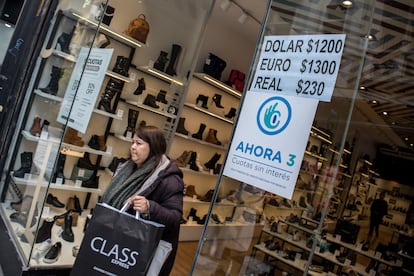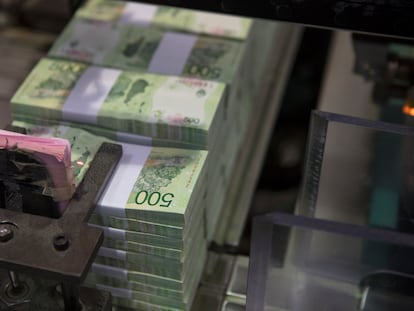The return of carry trade in Argentina: A financial maneuver generating 50% profit in dollars
The collapse of macroeconomic variables in the country allows for high-risk speculative strategies with unique margins


If you are Argentine and can save, you will almost certainly do so in dollars. But imagine the government tells you that it will depreciate the peso at a rate of 2% per month. But if you buy pesos, it will pay you between 4% and 5% interest on them monthly. Your financial advisor will then recommend a very simple operation: exchange your dollars for pesos, buy bonds with those pesos or put them in a fixed term interest account, and buy dollars again once the difference has been harvested at the end of the month.
The difference between the peso depreciation promised by the government and the interest rate you will have received will determine your profit margin. It sounds like a tongue twister, but it is an operation with a name and a surname: In Argentina, it is known as the “financial bicycle”; traders prefer to call it carry trade. It involves investors buying riskier currencies in the hope of pocketing enough interest to more than cover exchange rate losses.
The carry trade was a classic investment model during the Argentine dictatorship of the 1970s, revived in 2016 with Mauricio Macri, and now back again with the far-right leader Javier Milei. Argentines who have “ridden” the bicycle have gained up to 50% profit in dollars over the space of 10 months, another miracle to emerge from the Argentine macroeconomic meltdown.
For the bicycle wheel to spin, a number of conditions must be contradictory: a confluence of high interest rates on local currency along with evidence of its weakness against an appreciation of that currency against the dollar, which implies strength. As Argentina is usually an exception to the rule regarding macroeconomics, speculators invariably cream off high-risk profits there. Right now, the conditions are ideal. In a bid to control inflation, Milei’s government set the peso depreciation at 2% per month, two points less than average inflation. And, since it needs to clear the market of an excess of pesos, it is offering rates above inflation, up to 5%, to exchange them for dollars. Add to the mix a foreign exchange ceiling: i.e., the purchase and sale of foreign currency is controlled by the state, preventing free floating. The scenario is completed with the laundering of capital which introduced $12 billion into the market, which went to the banks and strengthened international reserves.
As investors are confident that Milei will defend the backward exchange rate at any cost and not back down on his war against inflation, they are encouraged to carry trade, with quicker and more lucrative profits than, for example, an investment in capital goods such as industrial machinery. This has been going on since January, and for now the wheels are still spinning, to the benefit of high-risk investors. The consequences for the real economy are obvious.
The financial bicycle is tempting, but it is also extremely risky. All it takes is a devaluation of the dollar for the spread between the initial investment in pesos and the repurchase of dollars to vanish. This happened in 2018, when investors who had acquired peso bonds lost confidence in Macri’s government and fled in a mass exit. The Central Bank went so far as to sell almost $1.5 billion of its reserves in a single day to contain the value of the currency, but it wasn’t enough. In April, when the crisis began, a dollar could be bought for 20 pesos; two months later the exchange rate had already exceeded 30 pesos per dollar. What is clear to investors is that the conditions that allow them to profit from the carry trade are short-lived because, for an economy to function, they cannot be sustained.
Is Milei’s economic model, based on a lagged dollar and high interest rates, running out of steam? “The question has been posed, but for the moment only among the consulting firms,” says an operator who prefers not to give his name. “The question is how long the government will be able to sustain the 2% monthly devaluation, with inflation hovering around 4%, without the exchange rate backwardness becoming unsustainable. Also, is this stabilization process going to find a way not to devalue in order to lift the exchange rate trap, which implies eliminating the gap between the dollar rates fixed by the Central Bank and the financial ones,” which float without the government’s intervention, he explains.
If doubts are growing, why do the operations continue? Well, because stratospheric profits have been made over the past 10 months and what counts is the balance at the end of the process. So, who stands to lose the most? Those who entered the system late, as happens with those who are left at the bottom of Ponzi-type pyramid schemes. “There is a phrase among investors that says flow [induced trading] kills fundamentals,” the source explains. “We could say that Argentina is expensive in dollars due to the exchange backwardness, but if the government continues to intervene with reserves to keep the price of financials down and the money from the laundering also enters, we could fall even further behind. The game is to time it right. If you are stuck with debt in pesos and there is a devaluation, you’re looking at a big loss,” he explains.
Sign up for our weekly newsletter to get more English-language news coverage from EL PAÍS USA Edition
Tu suscripción se está usando en otro dispositivo
¿Quieres añadir otro usuario a tu suscripción?
Si continúas leyendo en este dispositivo, no se podrá leer en el otro.
FlechaTu suscripción se está usando en otro dispositivo y solo puedes acceder a EL PAÍS desde un dispositivo a la vez.
Si quieres compartir tu cuenta, cambia tu suscripción a la modalidad Premium, así podrás añadir otro usuario. Cada uno accederá con su propia cuenta de email, lo que os permitirá personalizar vuestra experiencia en EL PAÍS.
¿Tienes una suscripción de empresa? Accede aquí para contratar más cuentas.
En el caso de no saber quién está usando tu cuenta, te recomendamos cambiar tu contraseña aquí.
Si decides continuar compartiendo tu cuenta, este mensaje se mostrará en tu dispositivo y en el de la otra persona que está usando tu cuenta de forma indefinida, afectando a tu experiencia de lectura. Puedes consultar aquí los términos y condiciones de la suscripción digital.
More information
Archived In
Últimas noticias
There is as much life left to discover on planet Earth as that which is already known
Dozens presumed dead, around 100 injured in fire at Swiss Alps bar during New Year’s celebration
Is porn for women different from conventional porn? We spoke to those who make it
Cartagena de Indias is sinking: What can the city do to mitigate it?
Most viewed
- David King, chemist: ‘There are scientists studying how to cool the planet; nobody should stop these experiments from happening’
- Reinhard Genzel, Nobel laureate in physics: ‘One-minute videos will never give you the truth’
- Oona Chaplin: ‘I told James Cameron that I was living in a treehouse and starting a permaculture project with a friend’
- Sinaloa Cartel war is taking its toll on Los Chapitos
- The Interoceanic Train, the Mexican alternative to the Panama Canal










































